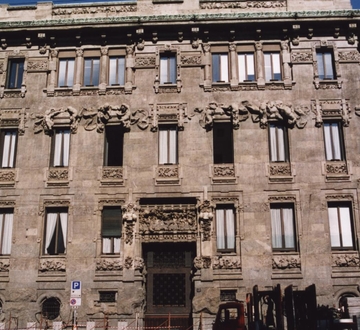Castiglioni Palace in Milan
Corso Venezia, 47/49 20121 Milano
Project for conservative restoration of the façade
The cleaning and conservative restoration works of the main façade in Corso Venezia can be summarized as follows:
- A phase for preliminary sampling:
- Sampling of the surface of the stone façade
- Sampling of the stone and concrete decorations
- Sampling of the copper decorations
- Sampling of the iron decorations
- Sampling of mortars.
- A phase of executive works:
- Preparation of scaffolding
- Completion of sampling
- Preliminary cleaning of the entire façade by low pressure vapour
- Cleaning of stone and concrete decorations
- Removal of the thick black scabs using specific reagents at suitable intervals
- Cleaning of copper and iron parts by means of brushing with specific products followed by passivation, iron coating, and antioxidant protection of the copper
- Cleaning of graffitis on skirting
- Removal of the protective translucent coatings visible from the ground, applied in previous interventions
- Mechanical removal of previous unsuitable reconstructions and seals by means of specific pneumatic micro chisels, chisels and scalpels
- Pivoting, when necessary, prepared with fiberglass rods of various diameters and two-component epoxy resin
- Structural and material consolidation
- Integrations and seals, when absolutely necessary, by means of specific mortars formulated with suitable inert selected for color and grain size, and binders satisfying the requirements of water availability and free from water-soluble and hygroscopic salts (according to sampling)
- Chemical consolidation of the disconnected stone surfaces when necessary
- Water-repellent treatment of the whole façade by specific siloxanic, colorless, opaque and UV-resistant product
- Antigraffiti treatment of the bottom part up to 3 m of the façade by a polyacrylic - siloxanic product dispersed in water, colorless and UV-resistant and eventually removable with hot water.
By Carlo Bono and Stefania Locatelli






















